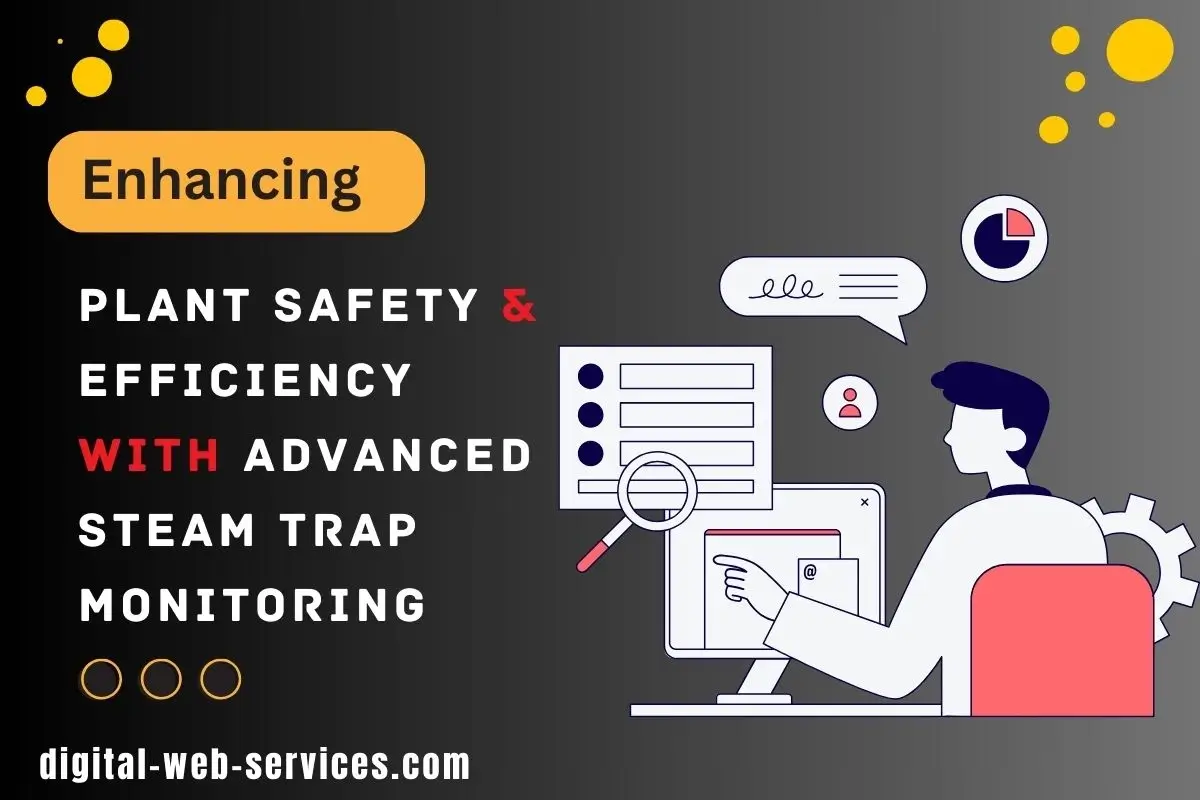
In industrial operations, plant safety and efficiency are of utmost importance – a well-functioning plant protects the lives of employees and allows for maximum productivity and reduced operational costs. One important but often overlooked component of plant safety and efficiency is steam trap monitoring. This blog will explore the basics of steam traps, the challenges with traditional steam trap monitoring techniques, and how modern monitoring systems solve these challenges and increase plant safety and efficiency.
The Basics of Steam Traps
Definition of steam traps, their purpose
Steam traps are mechanical devices used in steam systems to remove condensate (water) and non-condensable gasses without allowing the valuable steam to escape. Their primary job is to continue to be steam system efficiency – to allow equipment like heat exchangers, valves and coils to work as designed. Steam traps use the difference in temperature and pressure to open and drain while staying closed and allowing steam to escape.
Different types of steam traps
There are several types of steam traps, and each operates with a unique mechanism to ensure efficient condensate drainage. Mechanical traps, including float and thermostatic traps, inverted bucket traps, and disc traps operate with a mechanical mechanism that responds to temperature or pressure changes. Thermodynamic traps, consisting of disc traps and impulse traps, use the dynamic effects produced by steam flow and pressure changes to open and close. Thermostatic traps, such as balanced pressure traps and bimetallic traps, are equipped with a temperature-responsive element, like a bellows or a bimetallic element, to close and open the steam trap.
Importance of steam trap maintenance
Steam trap maintenance is critical for ensuring steam traps function correctly. Steam traps can malfunction over time due to conditions such as wear and tear, dirt, freezing or incorrect installation. Left unchecked, a malfunctioning steam trap can lead to a loss of energy, waste, and even equipment damage. Regular maintenance and inspection can help identify potential issues and repair the problem before it escalates and impacts the performance of the steam trap.
The Challenges of Traditional Steam Trap Monitoring
Manual inspection methods and their drawbacks
Traditionally, steam traps have been monitored through manual inspection methods. These methods often involve visual inspections to identify signs of leakage, physical damage, or blockages. While manual inspections are better than no monitoring at all, they have their limitations. Firstly, manual inspections are time-consuming and can be prone to human error. Additionally, they are often infrequent, which means that steam traps can malfunction for extended periods before being identified and repaired.
Inefficiencies and risks associated with outdated monitoring systems
Beyond manual inspections, some industries may rely on outdated monitoring systems that lack real-time data and continuous monitoring capabilities. These systems may only provide intermittent readings or rely on pre-set alarm thresholds, leading to missed or delayed detection of faulty steam traps. Outdated monitoring systems can increase the risk of energy waste, equipment damage, and downtime. Moreover, they do not facilitate proactive maintenance practices, which can further exacerbate these issues.
The Benefits of Advanced Steam Trap Monitoring
Introduction to advanced monitoring systems and technologies
Iles shared the following example to illustrate the benefits of advanced steam trap monitoring technology: “Imagine for a moment a bucket with the faucet turned on,” he began. “Now, imagine this water is steam, and you have 20 of these buckets. Each one is fitted with a float that rises and falls with the water level, and these floats are all connected with one wire, so as one goes up, they all go up. These floats are like a simple switch, and each one is monitoring a steam trap, so as long as the float stays down, the trap is working.
The bucket, faucet and float are like the header, steam trap and bucket system. “When the steam trap fails, the float will go up, indicating that the trap has failed,” Iles continued. Bluetooth, analog and time (BAT) technology, however, is like using motion-activated video recording to monitor this bucket system. The technology uses predictive analytics that can monitor and analyze millions of these buckets, so that when a float starts to go up, it can pick it up right away. “It’s not just looking at the float. It’s analyzing how high it goes, how long it takes to go down, if it goes up higher than the last time and then back down again,” he explained. “They’re actually looking at the wave patterns. So, for the first time, we can monitor this and not only predict imminent failure, but we’ll know that the bucket will fail 11.8 days before the float fails. That’s important, because now we have time to plan, schedule and make those repairs.”
Enhanced safety and efficiency in plant operations
By leveraging advanced monitoring capabilities, plant operators can realize significant improvements in both the safety and efficiency of their plants. Regular maintenance and the early, proactive identification of steam traps that are not working properly minimizes the possibility of energy being wasted, which in turn reduces operational costs and environmental impact. Moreover, an advanced monitoring system ensures that steam traps are functioning properly and play a critical role in maintaining equipment life, reducing the time in the field that the equipment is out of service and improving the overall efficiency of the plant.
Key Features and Functionality of Advanced Monitoring Systems
Remote monitoring capabilities
Remote monitoring capabilities are a hallmark of an advanced steam trap monitoring system. With remote access, plant personnel can monitor steam trap performance from any location, virtualizing the need for personnel to be on-site for manual inspections. Remote monitoring from an advanced steam trap monitoring system provides real-time visibility to a plant’s operations and enables plant personnel to respond immediately to any anomalies.
Condition-based monitoring and predictive maintenance
A key functionality of an advanced steam trap failure detection system is its condition-based monitoring capabilities. By continuously monitoring a variety of parameters such as temperature and pressure differentials, the advanced steam system can assess the performance of a steam trap and discover potential issues before they become a problem. This information can then be used to implement a predictive maintenance strategy where the steam traps that are not functioning properly are repaired or replaced in a timely manner.
To maximize the benefits of advanced steam trap monitoring, integration with plant control systems is essential. By integrating monitoring systems with existing plant infrastructure, companies can share and analyze the data collected about steam trap behavior. This provides a more comprehensive understanding of how steam traps contribute to overall plant operations and allows facilities staff to make data-driven decisions about steam trap maintenance and optimization.
Advanced steam trap monitoring systems may also come with alerting and reporting mechanisms. When the system detects abnormal steam trap performance, it can automatically send alerts to the appropriate personnel, which minimizes the time from detection to response. The system will also generate detailed reports that provide insights into historical trends in steam trap behavior, empowering staff to make data-driven decisions about ongoing maintenance and steam trap optimization.
Implementing advanced steam trap monitoring systems requires companies to carefully consider the financial implications of such a project. There will be initial investment costs associated with the purchase and installation of the monitoring systems, so organizations need to evaluate their current financial position and budget accordingly for implementation. These project teams should also forecast the ROI that such monitoring systems will deliver, as it will help them identify both the short- and long-term cost savings delivered by advanced monitoring technology.
Training and education for employees: Training and education are critical to ensure plant personnel can fully leverage advanced steam trap monitoring systems. Employees throughout the facility must be able to operate and maintain the monitoring systems. Training programs should aim to help employees understand the critical importance of steam trap monitoring, interpret the data generated by the systems and take effective action when an alert is issued or a report provided.
Collaboration with industry peers and experts: Collaboration with industry peers and experts can help plants avoid potential implementation pitfalls and ensure successful integration of advanced steam trap monitoring systems. Peers may have already encountered and solved most of the challenges of implementing advanced monitoring — including the identification of best practices for integration and lessons learned — and can offer some valuable guidance during implementation. Experts can provide valuable advice in selecting, implementing and optimizing advanced monitoring systems, and can offer support throughout the process.
Conclusion
Ensuring plant safety and efficiency are top concerns for industrial operators. Advanced steam trap monitoring systems are available to help plant operators overcome the challenges of conventional monitoring that offers real time data, continuous monitoring, and increased accuracy in detecting faulty traps. Employing these systems will enable operators to establish a safer plant, while reducing energy waste, downtime, and enhancing overall plant efficiency. Financial assessments, training of personnel, and collaboration are mandatory for flawless adoption. Recognizing the advantages of advanced steam trap monitoring systems, and implementing them as part of an effort to optimize and sustain the plant, is the challenge for industry.
Digital Web Services (DWS) is a leading IT company specializing in Software Development, Web Application Development, Website Designing, and Digital Marketing. Here are providing all kinds of services and solutions for the digital transformation of any business and website.










